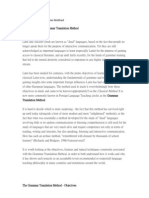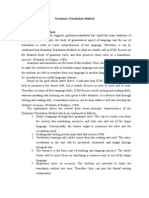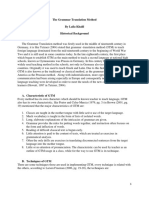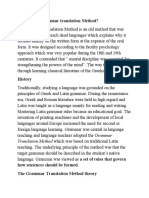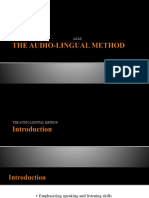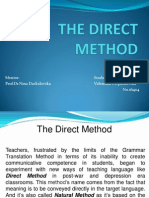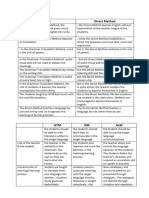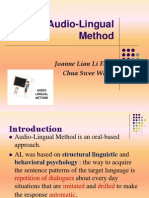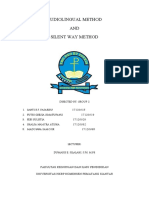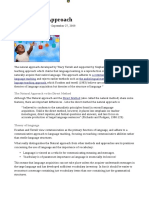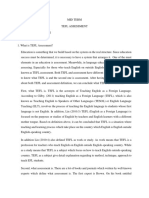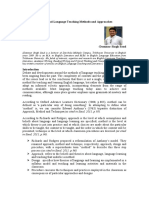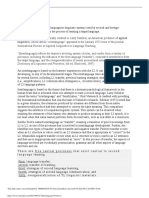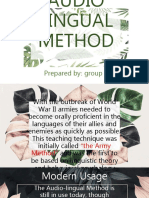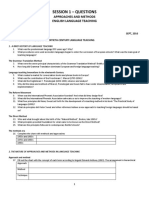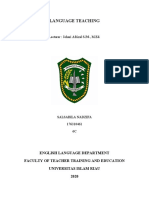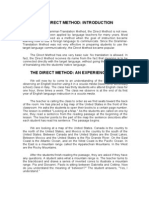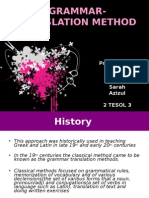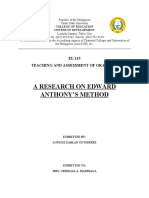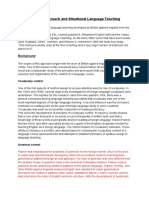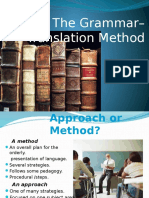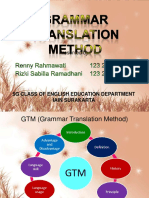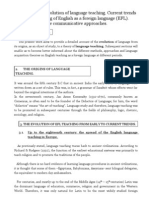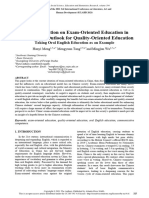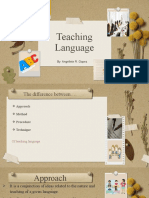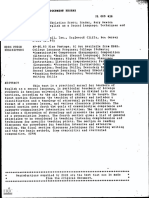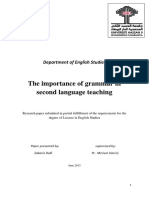Opciones metodolgicas actuales en la enseanza del ingls como L2
Micro-teaching simulation / individual presentation
Virginia Escudero Carranza
01/12/16
THE GRAMMAR-TRANSLATION METHOD (GTM): BACKGROUND
INFORMATION AND PRINCIPLES
THE LANGUAGE BOX
Deductive: an approach to language teaching in which learners are taught rules that they have
to apply when they use the language.
Grammar: in this method, "grammar" refers to the explicit morphological and syntactic rules
that are taught to learners.
Prussian Method: the GTM was first known as Prussian Method because it was first
institutionalised in Prussia, which dismembered in 1947 and whose capital was Berlin.
Paradigm: a list or pattern showing the forms which a word can have in a grammatical system.
They may be used to show the different forms of a verb.
Please note that the British English spelling variation has been used in this handout, and
therefore you may read verbs such as "emphasise" or "memorise", instead of "emphasize" or
"memorize".
1. NAME, ACRONYM, MAIN PERIOD, AND BASIC LANGUAGE-TEACHING
BACKGROUND:
The Grammar-Translation Method (GTM), also known as Prussian Method or Classical
Method, was based on the traditional way Latin and Greek were taught in Europe. It became
institutionalised as a modern language teaching method in schools in Prussia in the midnineteenth century and it has been dominant until 1940s.
2. TEACHER'S GOALS:
The teacher is the authority in the classroom. They teach grammar rules and vocabulary items of
the target language, and they emphasise accuracy during translation activities.
3. CHARASTERISTICS OF THE TEACHING AND LEARNING PROCESSES:
The sentence is the basic unit of teaching and language practice. Students must be able to read
target language literature, and to translate from and into it. Readings about some cultural aspect
of the target language community are often translated.
Grammar is studied deductively. The vocabulary selection is based on the reading texts, and
words are taught through bilingual word lists, dictionary study and memorisation.
4. THE WAY THE STUDENTS' FEELINGS THEIR NEEDS, PREFERENCES,
OPINIONS, INTERESTS ARE DEALT WITH:
There are no principles of the method which relate to this area. The method was designed for a
generic student.
�5. THE L2 AREAS/COMPONENTS AND SKILLS THAT ARE EMPHASISED:
Vocabulary and grammar are emphasized. The main skills to be developed are reading and
writing. Students must be able to translate from and into the target language.
6. THE WAY GRAMMATICAL STRUCTURES ARE PRESENTED AND PRACTISED:
Grammar is studied deductively: students must learn and memorise the grammar rules and
examples, and apply the rules to other examples.
7. THE ROLE OF THE STUDENTS' L1 IN CLASS:
The students' native language is the medium of instruction. Students memorise native language
equivalents for target language vocabulary words. Learning is facilitated through attention to
similarities between the target language and the native language, and by translation into the
native language.
8. TEACHER TREATMENT OF STUDENT ERRORS IN THE L2:
It is very important that students get the correct answer. If students make errors or do not know
an answer, the teacher supplies them with the correct answer.
9. THE WAY EVALUATION/ASSESSMENT IS ACCOMPLISHED:
Evaluation is accomplished through written tests in which students are asked to translate from
or into the target language. Questions about the target culture or questions that ask students to
apply grammar rules are also common.
Accuracy is emphasised. Students are expected to attain high standards in translation.
10. MY PERSONAL OPINION OF THIS METHOD/APPROACH (PERCEIVED
STRENGTHS AND WEAKNESSES FOLLOWED BY SPECIFIC EXAMPLES):
This method may be useful when understanding literary texts is the main goal of foreign
language study and there is little need for a speaking knowledge (e.g., current classical Greek
learning).
However, the method is ineffective in teaching learners how to use the foreign language for
communicative purposes (e.g., learning English to communicate in job meetings), since it
ignores speaking and listening skills.
REFERENCES:
Byram, M. 2000. Routledge Encyclopedia of Language Teaching and Learning.
Routledge. (250-252).
Larsen-Freeman, D. & Anderson, M. 2011 (3rd edition). Techniques and Principles in
Language Teaching. Oxford: Oxford University Press. (13-23).
Loewen, S. & Reinders, H. 2011. Key Concepts in Second Language Acquisition.
Palgrave. (76-77).
Opciones metodolgicas actuales en la enseanza del ingls como L2. Class Booklet.
Richards, J. & Schmidt, R. 2010 (4th edition). Longman Dictionary of Language
Teaching and Applied Linguistics. London: Longman. (158, 251-253, 418).
Richards, J. C. & Rodgers, T. S. 2014 (3rd edition). Approaches and Methods in
Language Teaching. Cambridge: Cambridge University Press. (1-5).
Thornbury, S. 2006. An A-Z of ELT. Oxford: Macmillan. (94-95).


